For the 2025 school year, there are 2 public elementary schools serving 1,058 students in San Diego Independent School District. This district's average elementary testing ranking is 4/10, which is in the bottom 50% of public elementary schools in Texas.
Public Elementary Schools in San Diego Independent School District have an average math proficiency score of 34% (versus the Texas public elementary school average of 42%), and reading proficiency score of 44% (versus the 52% statewide average).
Minority enrollment is 99% of the student body (majority Hispanic), which is more than the Texas public elementary school average of 75% (majority Hispanic).
Overview
This School District
This State (TX)
# Schools
3 Schools
6,902 Schools
# Students
1,513 Students
3,737,053 Students
# Teachers
104 Teachers
255,471 Teachers
Student : Teacher Ratio
15:1
15:1
District Rank
San Diego Independent School District, which is ranked #860 of all 1,196 school districts in Texas (based off of combined math and reading proficiency testing data) for the 2021-2022 school year.
The school district's graduation rate of 90-94% has increased from 80-84% over five school years.
Overall District Rank
#863 out of 1204 school districts
(Bottom 50%)
(Bottom 50%)
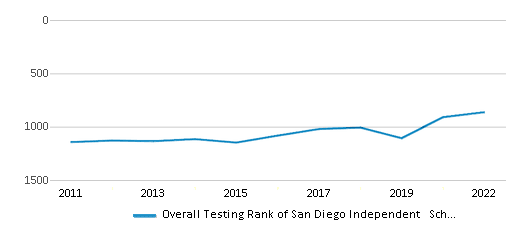
Math Test Scores (% Proficient)
35%
41%

Reading/Language Arts Test Scores (% Proficient)
40%
51%
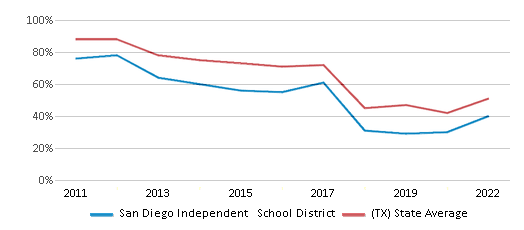
Science Test Scores (% Proficient)
34%
46%

Graduation Rate
90-94%
90%

Students by Ethnicity:
Diversity Score
0.03
0.64
# American Indian Students
n/a
11,705 Students
% American Indian Students
n/a
n/a
# Asian Students
4 Students
203,767 Students
% Asian Students
n/a
6%
# Hispanic Students
1,489 Students
1,997,454 Students
% Hispanic Students
99%
53%
# Black Students
n/a
469,194 Students
% Black Students
n/a
13%
# White Students
19 Students
924,841 Students
% White Students
1%
25%
# Hawaiian Students
n/a
5,879 Students
% Hawaiian Students
n/a
n/a
# Two or more races Students
1 Student
124,213 Students
% of Two or more races Students
n/a
3%
Students by Grade:
# Students in PK Grade:
124
222,501
# Students in K Grade:
84
346,866
# Students in 1st Grade:
96
385,427
# Students in 2nd Grade:
103
402,148
# Students in 3rd Grade:
114
399,623
# Students in 4th Grade:
116
398,690
# Students in 5th Grade:
83
399,071
# Students in 6th Grade:
119
402,143
# Students in 7th Grade:
114
335,034
# Students in 8th Grade:
105
339,814
# Students in 9th Grade:
122
32,833
# Students in 10th Grade:
115
28,116
# Students in 11th Grade:
111
23,862
# Students in 12th Grade:
107
20,925
# Ungraded Students:
-
-
District Revenue and Spending
The revenue/student of $16,925 is higher than the state median of $13,387. The school district revenue/student has stayed relatively flat over four school years.
The school district's spending/student of $15,718 is higher than the state median of $14,116. The school district spending/student has stayed relatively flat over four school years.
Total Revenue
$26 MM
$74,029 MM
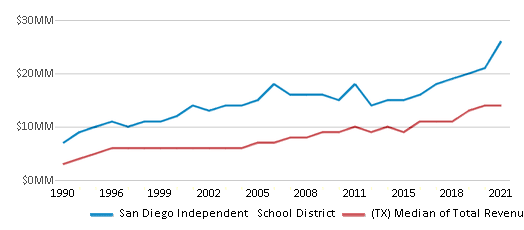
Spending
$24 MM
$78,063 MM
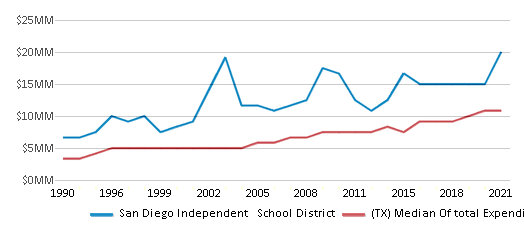
Revenue / Student
$16,925
$13,387
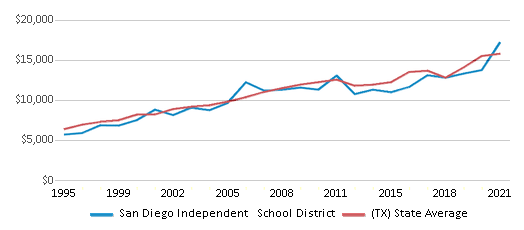
Spending / Student
$15,718
$14,116
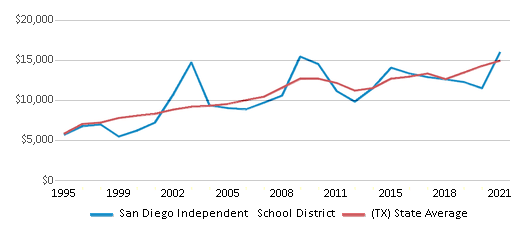
Best San Diego Independent School District Public Elementary Schools (2025)
School
(Math and Reading Proficiency)
(Math and Reading Proficiency)
Location
Grades
Students
Rank: #11.
Bernarda Jaime J High School
(Math: 35% | Reading: 46%)
Rank:
Rank:
4/
Bottom 50%10
609 W Labbe Ave
San Diego, TX 78384
(361) 279-3373
San Diego, TX 78384
(361) 279-3373
Grades: 6-8
| 338 students
Rank: #22.
Collins-parr Elementary School
(Math: 33% | Reading: 41%)
Rank:
Rank:
3/
Bottom 50%10
609 W Labbe Ave
San Diego, TX 78384
(361) 279-3382
San Diego, TX 78384
(361) 279-3382
Grades: PK-5
| 720 students
Recent Articles

Year-Round Or Traditional Schedule?
Which is more appropriate for your child? A year-round attendance schedule or traditional schedule? We look at the pros and cons.

Why You Should Encourage Your Child to Join a Sports Team
Participating in team sports has a great many benefits for children, there is no doubt. In this article you will learn what those benefits are.

White Students are Now the Minority in U.S. Public Schools
Increasing birth rates among immigrant families from Asia and Central and South America, combined with lower birth rates among white families, means that for the first time in history, public school students in the United States are majority-minority. This shift in demographics poses difficulties for schools as they work to accommodate children of varying language abilities and socio-economic backgrounds.





